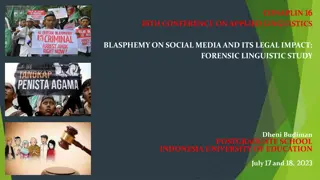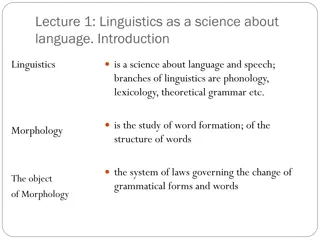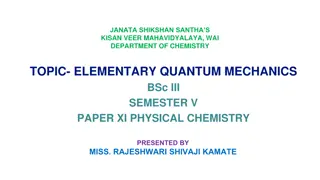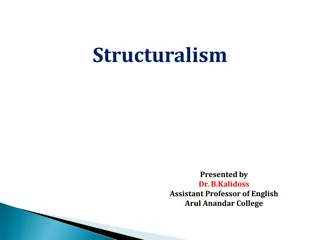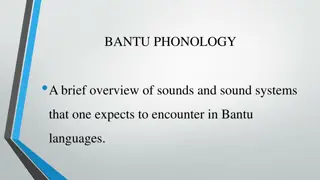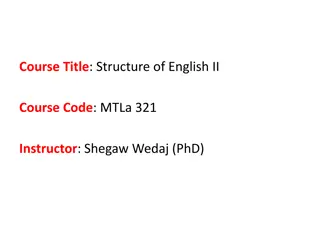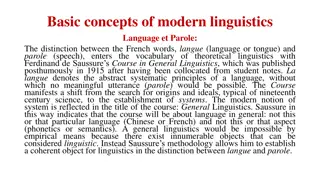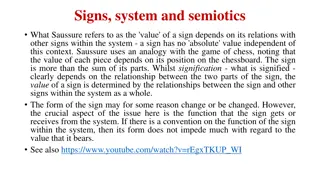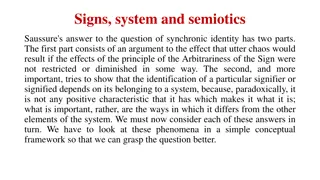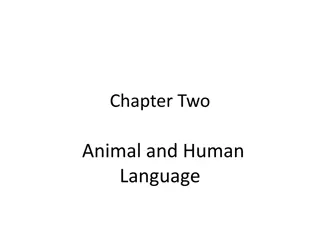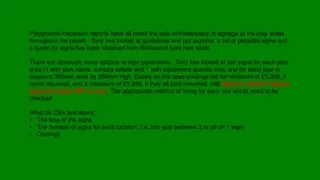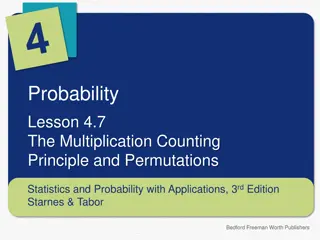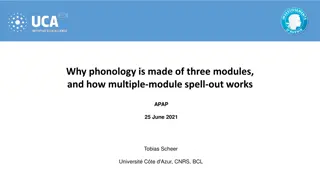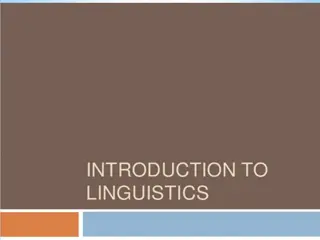The Principle of Arbitrariness in Linguistic Signs: Saussure's Insight
Saussure's declaration on the arbitrariness of linguistic signs is thought-provoking, emphasizing that while signs are arbitrary, complete arbitrariness would lead to chaos. He distinguishes between degrees of arbitrariness and acknowledges that signs are not entirely arbitrary, being subject to linguistic conventions. The relationship between signifiers and signifieds highlights the relative autonomy within sign systems, influenced by historical and social contexts.
Download Presentation

Please find below an Image/Link to download the presentation.
The content on the website is provided AS IS for your information and personal use only. It may not be sold, licensed, or shared on other websites without obtaining consent from the author.If you encounter any issues during the download, it is possible that the publisher has removed the file from their server.
You are allowed to download the files provided on this website for personal or commercial use, subject to the condition that they are used lawfully. All files are the property of their respective owners.
The content on the website is provided AS IS for your information and personal use only. It may not be sold, licensed, or shared on other websites without obtaining consent from the author.
E N D
Presentation Transcript
A Dilemma: Arbitrariness vs. System Saussure declares that 'the entire linguistic system is founded upon the irrational principle that the sign is arbitrary'. This provocative declaration is followed immediately by the acknowledgement that 'applied without restriction, this principle would lead to utter chaos. If linguistic signs were to be totally arbitrary in every way language would not be a system and its communicative function would be destroyed. He concedes that 'there exists no language in which nothing at all is motivated' (ibid.). Saussure admits that 'a language is not completely arbitrary, for the system has a certain rationality'. The principle of arbitrariness does not mean that the form of a word is accidental or random, of course. Whilst the sign is not determined extralinguistically it is subject to intralinguistic determination. For instance, signifiers must constitute well-formed combinations of sounds which conform with existing patterns within the language in question. Furthermore, we can recognize that a compound noun such as 'screwdriver' is not wholly arbitrary since it is a meaningful combination of two existing signs. Saussure introduces a distinction between degrees of arbitrariness: The fundamental principle of the arbitrary nature of the linguistic sign does not prevent us from distinguishing in any language between what is intrinsically arbitrary - that is, unmotivated - and what is only relatively arbitrary. Not all signs are absolutely arbitrary. In some cases, there are factors which allow us to recognize different degrees of arbitrariness, although never to discard the notion entirely. The sign may be motivated to a certain extent. Here then Saussure modifies his stance somewhat and refers to signs as being 'relatively arbitrary'. Some subsequent theorists refer to the relationship between the signifier and the signified in terms of 'relative autonomy'. The relative conventionality of relationships between signified and signifier is a point which we will handle later.
A Dilemma: Arbitrariness vs. System It is noteworthy that whilst the relationships between signifiers and their signifieds are ontologically arbitrary (philosophically, it would not make any difference to the status of these entities in 'the order of things' if what we call 'black' had always been called 'white' and vice versa), this is not to suggest that signifying systems are socially or historically arbitrary. Natural languages are not, of course, arbitrarily established, unlike historical inventions such as Morse Code. Nor does the arbitrary nature of the sign make it socially 'neutral' or materially 'transparent' - for example, in Western culture 'white' has come to be a privileged signifier. Even in the case of the 'arbitrary' colours of traffic lights, the original choice of red for 'stop' was not entirely arbitrary, since it already carried relevant associations with danger. As L vi-Strauss noted, the sign is arbitrary a priori but ceases to be arbitrary a posteriori - after the sign has come into historical existence it cannot be arbitrarily changed. As part of its social use within a code (a term which became fundamental amongst post-Saussurean semioticians), every sign acquires a history and connotations of its own which are familiar to members of the sign-users' culture. Saussure remarked that although the signifier 'may seem to be freely chosen', from the point of view of the linguistic community it is 'imposed rather than freely chosen' because 'a language is always an inheritance from the past' which its users have 'no choice but to accept'. Indeed, 'it is because the linguistic sign is arbitrary that it knows no other law than that of tradition, and [it is] because it is founded upon tradition that it can be arbitrary'. The arbitrariness principle does not, of course mean that an individual can arbitrarily choose any signifier for a given signified. The relation between a signifier and its signified is not a matter of individual choice; if it were then communication would become impossible. 'The individual has no power to alter a sign in any respect once it has become established in the linguistic community'. From the point-of-view of individual language-users, language is a 'given' - we don't create the system for ourselves. Saussure refers to the language system as a non-negotiable 'contract' into which one is born - although he later problematizes the term. The ontological arbitrariness which it involves becomes invisible to us as we learn to accept it as 'natural'.
A Dilemma: Arbitrariness vs. System The Saussurean legacy of the arbitrariness of signs leads semioticians to stress that the relationship between the signifier and the signified is conventional - dependent on social and cultural conventions. This is particularly clear in the case of the linguistic signs with which Saussure was concerned: a word means what it does to us only because we collectively agree to let it do so. Saussure felt that the main concern of semiotics should be 'the whole group of systems grounded in the arbitrariness of the sign'. He argued that: 'signs which are entirely arbitrary convey better than others the ideal semiological process. That is why the most complex and the most widespread of all systems of expression, which is the one we find in human languages, is also the most characteristic of all. In this sense, linguistics serves as a model for the whole of semiology, even though languages represent only one type of semiological system'. He did not in fact offer many examples of sign systems other than spoken language and writing, mentioning only: the deaf-and-dumb alphabet; social customs; etiquette; religious and other symbolic rites; legal procedures; military signals and nautical flags. Saussure added that 'any means of expression accepted in a society rests in principle upon a collective habit, or on convention - which comes to the same thing . However, whilst purely conventional signs such as words are quite independent of their referents, other less conventional forms of signs are often somewhat less independent of them. Nevertheless, since the arbitary nature of linguistic signs is clear, those who have adopted the Saussurean model have tended to avoid 'the familiar mistake of assuming that signs which appear natural to those who use them have an intrinsic meaning and require no explanation .
Signs and semiotics In almost the same period as Saussure was formulating his model of the sign, of 'semiology' and of a structuralist methodology, across the Atlantic independent work was also in progress as the pragmatist philosopher and logician Charles Sanders Peirce formulated his own model of the sign, of 'semiotic' and of the taxonomies of signs. In contrast to Saussure's model of the sign in the form of a 'self-contained dyad', Peirce offered a triadic model: The Representamen: the form which the sign takes (not necessarily material); An Interpretant: not an interpreter but rather the sense made of the sign; An Object: to which the sign refers. 'A sign... [in the form of a representamen] is something which stands to somebody for something in some respect or capacity. It addresses somebody, that is, creates in the mind of that person an equivalent sign, or perhaps a more developed sign. That sign which it creates I call the interpretant of the first sign. The sign stands for something, its object. It stands for that object, not in all respects, but in reference to a sort of idea, which are sometimes called the ground of the representamen'. The interaction between the representamen, the object and the interpretant is referred to by Peirce as 'semiosis'. Within Peirce's model of the sign, the traffic light sign for 'stop' would consist of: a red light facing traffic at an intersection (the representamen); vehicles halting (the object) and the idea that a red light indicates that vehicles must stop (the interpretant).
Signs and semiotics Peirce's model of the sign includes an object or referent - which does not, of course, feature directly in Saussure's model. The representamen is similar in meaning to Saussure's signifier whilst the interpretant is similar in meaning to the signified. However, the interpretant has a quality unlike that of the signified: it is itself a sign in the mind of the interpreter. Peirce noted that 'a sign... addresses somebody, that is, creates in the mind of that person an equivalent sign, or perhaps a more developed sign. The sign which it creates I call the interpretant of the first sign . Umberto Eco uses the phrase 'unlimited semiosis' to refer to the way in which this could lead (as Peirce was well aware) to a series of successive interpretants (potentially) ad infinitum. Elsewhere Peirce added that 'the meaning of a representation can be nothing but a representation'. Any initial interpretation can be re-interpreted. That a signified can itself play the role of a signifier is familiar to anyone who uses a dictionary and finds themselves going beyond the original definition to look up yet another word which it employs. This concept can be seen as going beyond Saussure's emphasis on the value of a sign lying in its relation to other signs and it was later to be developed more radically by poststructuralist theorists. Another concept which is alluded to within Peirce's model which has been taken up by later theorists but which was explicitly excluded from Saussure's model is the notion of dialogical thought. It stems in part from Peirce's emphasis on 'semiosis' as a process which is in distinct contrast to Saussure's synchronic emphasis on structure. Peirce argued that 'all thinking is dialogic in form. Your self of one instant appeals to your deeper self for his assent'. This notion resurfaced in a more developed form in the 1920s in the theories of Mikhail Bakhtin. One important aspect of this is its characterization even of internal reflection as fundamentally social.
Signs and semiotics Whereas Saussure emphasized the arbitrary nature of the (linguistic) sign, most semioticians stress that signs differ in how arbitrary/conventional (or by contrast 'transparent') they are. Symbolism reflects only one form of relationship between signifiers and their signifieds. Whilst Saussure did not offer a typology of signs, Charles Peirce was a compulsive taxonomist and he offered several logical typologies. However, his divisions and subdivisions of signs are extraordinarily elaborate: indeed, he offered the theoretical projection that there could be 59,049 types of signs! Peirce himself noted wryly that this calculation 'threatens a multitude of classes too great to be conveniently carried in one's head', adding that 'we shall, I think, do well to postpone preparation for further divisions until there be a prospect of such a thing being wanted'. However, even his more modest proposals are daunting: Susanne Langer commented that 'there is but cold comfort in his assurance that his original 59,049 types can really be boiled down to a mere sixty-six'. Unfortunately, the complexity of such typologies rendered them 'nearly useless' as working models for others in the field. However, one of Peirce's basic classifications (first outlined in 1867) has been very widely referred to in subsequent semiotic studies. He regarded it as 'the most fundamental' division of signs. It is less useful as a classification of distinct 'types of signs' than of differing 'modes of relationship' between sign vehicles and their referents. Note that in the subsequent account, I have continued to employ the Saussurean terms signifier and signified, even though Peirce referred to the relation between the 'sign' (sic) and the object, since the Peircean distinctions are most commonly employed within a broadly Saussurean framework. Such incorporation tends to emphasize (albeit indirectly) the referential potential of the signified within the Saussurean model. Here then are the three modes together with some brief definitions of Chandler and some illustrative examples:
Signs and semiotics Symbol/symbolic: a mode in which the signifier does not resemble the signified but which is fundamentally arbitrary or purely conventional - so that the relationship must be learnt: e.g. language in general (plus specific languages, alphabetical letters, punctuation marks, words, phrases and sentences), numbers, morse code, traffic lights, national flags; Icon/iconic: a mode in which the signifier is perceived as resembling or imitating the signified (recognizably looking, sounding, feeling, tasting or smelling like it) - being similar in possessing some of its qualities: e.g. a portrait, a cartoon, a scale-model, onomatopoeia, metaphors, 'realistic' sounds in 'programme music', sound effects in radio drama, a dubbed film soundtrack, imitative gestures; Index/indexical: a mode in which the signifier is not arbitrary but is directly connected in some way (physically or causally) to the signified - this link can be observed or inferred: e.g. 'natural signs' (smoke, thunder, footprints, echoes, non-synthetic odours and flavours), medical symptoms (pain, a rash, pulse-rate), measuring instruments (weathercock, thermometer, clock, spirit-level), 'signals' (a knock on a door, a phone ringing), pointers (a pointing 'index' finger, a directional signpost), recordings (a photograph, a film, video or television shot, an audio-recorded voice), personal 'trademarks' (handwriting, catchphrase) and indexical words ('that', 'this', 'here', 'there').
Signs and semiotics The three forms are listed here in decreasing order of conventionality. Symbolic signs such as language are (at least) highly conventional; iconic signs always involve some degree of conventionality; indexical signs 'direct the attention to their objects by blind compulsion'. Indexical and iconic signifiers can be seen as more constrained by referential signifieds whereas in the more conventional symbolic signs the signified can be seen as being defined to a greater extent by the signifier. Within each form signs also vary in their degree of conventionality. Other criteria might be applied to rank the three forms differently. For instance, Hodge and Kress suggest that indexicality is based on an act of judgement or inference whereas iconicity is closer to 'direct perception' making the highest 'modality' that of iconic signs. Note that the terms 'motivation' (from Saussure) and 'constraint' are sometimes used to describe the extent to which the signified determines the signifier. The more a signifier is constrained by the signified, the more 'motivated' the sign is: iconic signs are highly motivated; symbolic signs are unmotivated. The less motivated the sign, the more learning of an agreed convention is required. Nevertheless, most semioticians emphasize the role of convention in relation to signs. Even photographs and films are built on conventions which we must learn to 'read'. Such conventions are an important social dimension of semiotics. Peirce and Saussure used the term 'symbol' differently from each other. Whilst nowadays most theorists would refer to language as a symbolic sign system, Saussure avoided referring to linguistic signs as 'symbols', since the ordinary everyday use of this term refers to examples such as a pair of scales (signifying justice), and he insisted that such signs are 'never wholly arbitrary. They are not empty configurations'. They 'show at least a vestige of natural connection' between the signifier and the signified - a link which he later refers to as 'rational'. Whilst Saussure focused on the arbitrary nature of the linguistic sign, a more obvious example of arbitrary symbolism is mathematics. Mathematics does not need to refer to an external world at all: its signifieds are indisputably concepts and mathematics is a system of relations. For Peirce, a symbol is 'a sign which refers to the object that it denotes by virtue of a law, usually an association of general ideas, which operates to cause the symbol to be interpreted as referring to that object'. We interpret symbols according to 'a rule' or 'a habitual connection'. 'The symbol is connected with its object by virtue of the idea of the symbol-using animal, without which no such connection would exist'. It 'is constituted a sign merely or mainly by the fact that it is used and understood as such'. It 'would lose the character which renders it a sign if there were no interpretant'. A symbol is 'a conventional sign, or one depending upon habit (acquired or inborn)'. 'All words, sentences, books and other conventional signs are symbols'. Peirce thus characterizes linguistic signs in terms of their conventionality in a similar way to Saussure. In a rare direct reference to the arbitrariness of symbols (which he then called 'tokens'), he noted that they 'are, for the most part, conventional or arbitrary'. A symbol is a sign 'whose special significance or fitness to represent just what it does represent lies in nothing but the very fact of there being a habit, disposition, or other effective general rule that it will be so interpreted. Take, for example, the word "man". These three letters are not in the least like a man; nor is the sound with which they are associated'. He adds elsewhere that 'a symbol... fulfills its function regardless of any similarity or analogy with its object and equally regardless of any factual connection therewith' but solely because it will be interpreted as a sign.
References http://visual-memory.co.uk/daniel/Documents/S4B/sem02.html by Daniel Chandler Holcroft, David. 1991. Saussure, Signs, System andArbitrariness. Cambridge: CUP.


